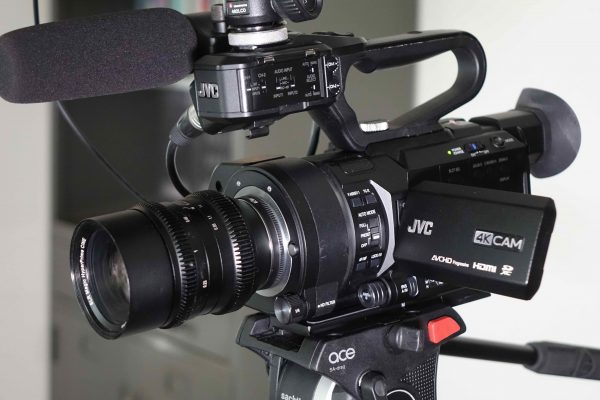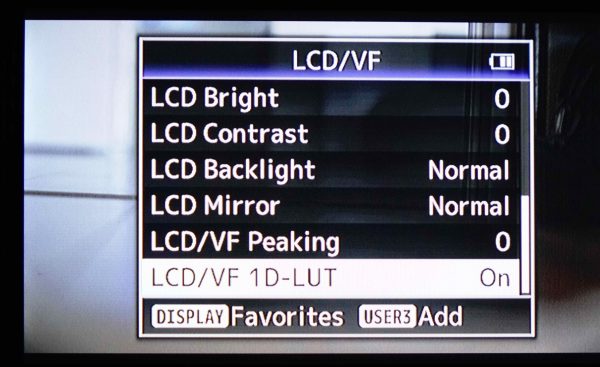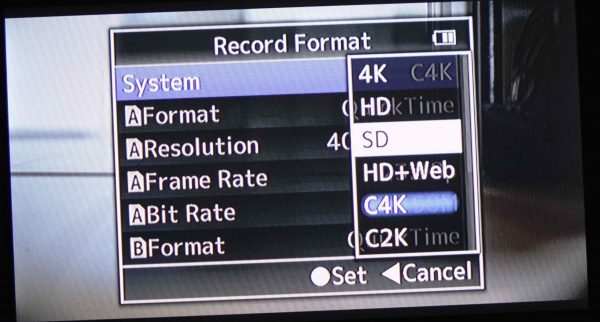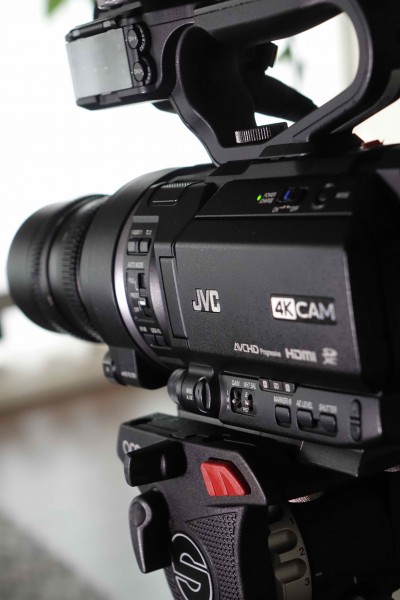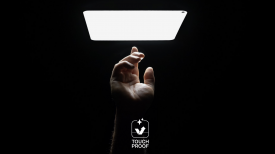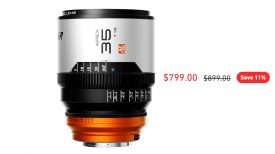By technical editor Matt Allard:
There is already an alphabet soup of LOG formats available on a wide range of cameras, and now JVC have given us J-Log. J-Log joins Sony S-Log, S-Log2, Slog-3, Canon C-Log, Canon C-Log2, Panasonic V-Log, V-Log L, Arri C-Log, Kinefinity KineLOG3 and REDlogFilm. JVC were showing new Version 2.0 firmware for the GY-LS300, that includes J-Log, on their stand at IBC. I was lucky enough to be able to test it out before it becomes publically available.
I tested the GY-LS300 back in February this year and I was quite impressed with the camera. The main thing that I felt was missing was the lack of any Log gamma curve. I found that the camera didn’t have a lot of dynamic range and you had to work around this to achieve the best results. JVC must of been listening and have made several improvements to the camera since I last used it.
J-Log is a welcome addition to the GY-LS300 and will be available in late September 2015 when Version 2.0 firmware is released. J-Log will give you 800% dynamic range. To put this is perspective a traditional REC709 gamma, without using a knee or slope, should hit its limit at 100% reflectance of light. This means in theory that J-Log should allow you to capture a brightness value that is 8 times greater than that of a REC709 gamma. For reference Sony’s S-Log2 is claimed to have a 1300% dynamic range.

I am not sure at this stage just exactly how many stops of dynamic range you will now get if you use J-Log on the GY-LS300, but it is certainly a big improvement compared to the previous gamma options. The J-Log1 gamma is quite flat, but it has more colour information in it than say S-Log or S-Log2. I have recently been testing out the Panasonic DVX-200 and V-Log L. Comparing the two, they both seem to offer similar levels of dynamic range, but I do prefer the way the JVC handles the highlights.
JVC have also included a J-LOG REC709 LUT in the camera that you can apply non destructively to the image. The only problem with the feature is that you can’t currently assign it to a user button and you need to go into the menus to turn it on and off. The LUT is also only 1D and not a 3D LUT, so certain third party LUT applications like LUT Buddy for FCPX won’t recognise it. JVC has told me that a 3D LUT version will be coming in the future.
If you shoot in J-log on the camera it does seem to respond quite well to grading and you don’t have to do too much to get a nice image. I compared J-log1, ITU709 and the Cinema gammas to see how well they dealt with skin tones.
Above are a few examples of vision shot in J-Log that has had various film emulation stocks applied.
I also did some ISO tests to see how the camera responded when recording Cinema 4K (4096 x 2160) at various ISOs in both ITU709 and J-Log1 gamma modes. Interestingly you can select lower ISO values of both 200 and 300 if you choose J-Log1. In ITU709 or Cinema gamma modes 400 ISO is the lowest setting available. I found from my tests that the camera is very usable up to about 1600 ISO, but it does start to get a little noisy once you go above that level. The added benefit of using J-log1 is that it has a lot more dynamic range than ITU709, so you won’t have to push the cameras ISO nearly as high when using it.
Along with J-Log there are a host of other new features in the Version 2.0 firmware:

Unique Prime Zoom feature (v2.0)
Prime lenses have a fixed focal length, but the GY-LS300’s new Prime Zoom feature takes advantage of JVC’s unique Variable Scan Mapping technology, which was created to electronically adapt the active area of the camera’s image sensor to provide native support of various lenses when paired with third-party lens adapters. When used with a Micro Four Thirds (MFT) prime lens, the image can be adjusted between the maximum scan area and minimum scan area using the camera’s zoom rocker. As a result, the camera can deliver 2.3x maximum zoom for HD or 1.25x maximum zoom for 4K. The new Prime Zoom feature can also be used as a lens extender for zoom lenses.
Cinema 4K and Cinema 2K Recording for the ultimate cinema look (Version 2.0 available September 2015)
Record images in Cinema 4K (4096 x 2160) at 150 or 70 Mbps, or Cinema 2K (2048 x 1920) at 50 Mbps. Both modes support recording in 23.98p or true 24p to match the frame rate of film.
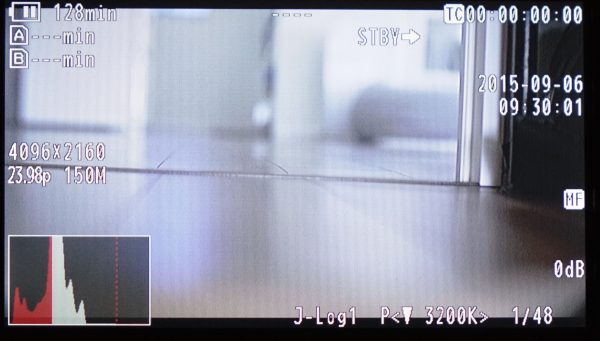
There is also a histogram, spot meter and options to change the colour matrix and black paint adjustments The histogram was something that was strangely left off the camera when it was first released, so I am glad that JVC has finally added it. The only problem with the histogram is that when activated it covers up the audio meter display so you can’t see it.
I tested out all the new features, but the one that stood out for me was the C2K and C4K Prime Zoom function. In C2K you can you shoot with a Super 35mm field of view or choose to crop in using the 2.3x Variable Scan Mapping function. This is an incredible feature and from my tests I did not find any noticeable loss of resolution or sharpness when using it. This really does make the GY-LS300 very unique. As you can see from my tests you can turn any lens into a multitude of focal lengths without losing light or changing the depth of field. If you plan on using M 4/3 lenses on the camera, the ability to turn a prime lens into a zoom lens and zoom using the rocker on the camera is a very nice feature.
Another welcome addition is the ability to now choose full Cinema 4K (4096 x 2160) at 150 or 70 Mbps, or Cinema 2K (2048 x 1920) at 50 Mbps. Both modes support recording in 23.98p or true 24p but unfortunately you cannot chose any PAL frame rates when using this setting.
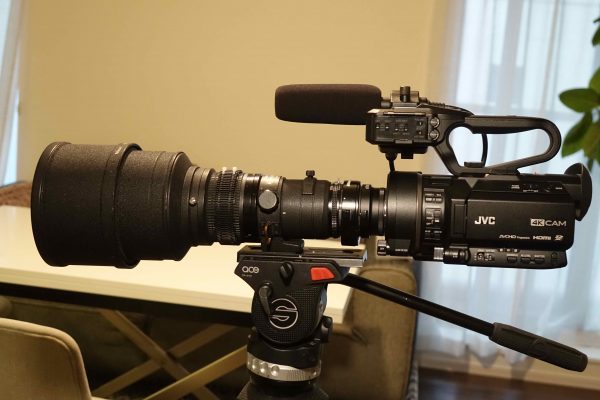
The ability to use 4/3 MFT lenses, older Super 16mm lenses, B4 2/3″, PL, and just about any other lens you can think of on the camera gives it a real edge on a lot of its competition. It is good to see JVC improve the GY-LS300’s abilities via firmware. They have definitely been listening to user feedback and implemented a lot of new functions and features that overall make the camera a lot more interesting proposition. I have to applaud JVC for thinking outside of the box and coming up with a camera that is quite unique compared to its competition.
The GY-LS300 has a lot of competition on its hands from cameras such as Sony’s just announced FS5, the Canon C100 Mark II, Blackmagic URSA Mini, and the upcoming Panasonic DVX 200. All of these cameras offer different levels of features and functionality. It was not that long ago that cameras in this price range all looked the same and offered almost identical features and performance. For the end user there is now a lot of choices in the sub $7k US price range and enough variation in the models and specifications that there is something for everyone.

